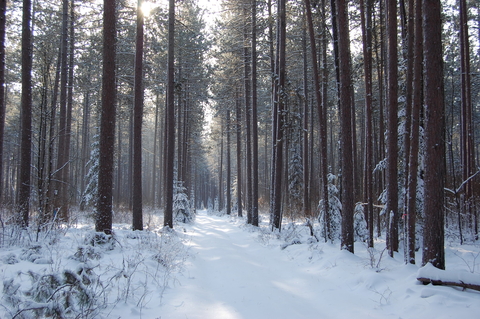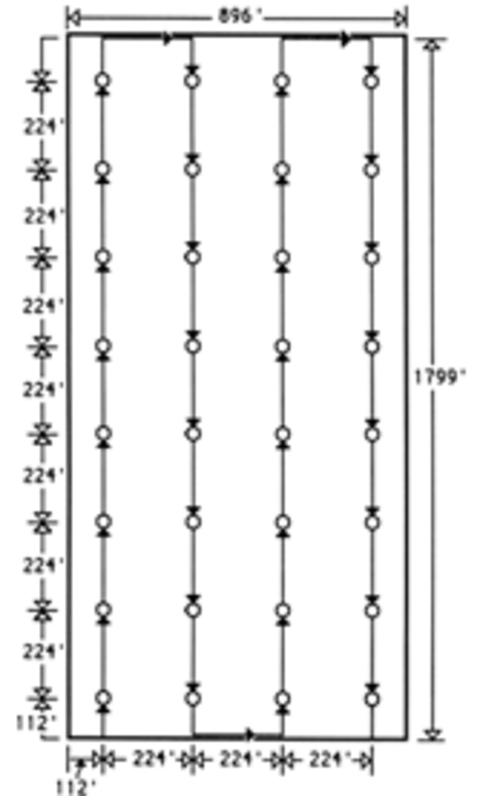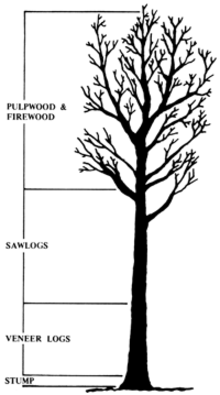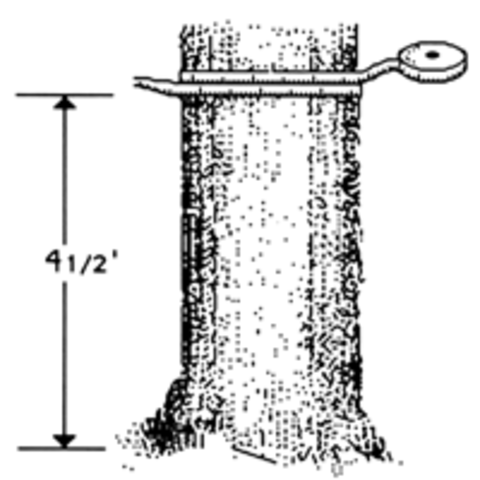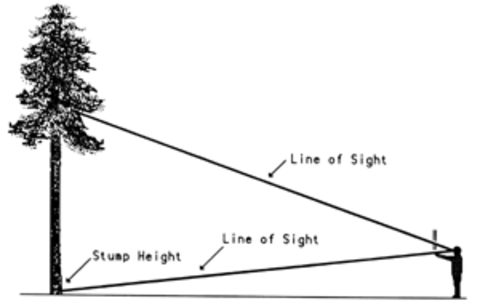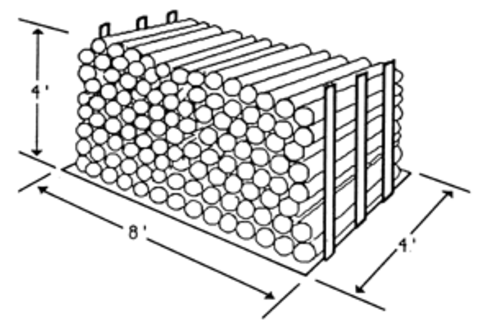Quick facts
- Professional foresters can help you with woodland management and timber measurements.
- Individually evaluate each tree or set up sample plots to estimate how much timber you have.
- The products you can make depend on the tree’s usable length.
- Estimate the tree diameter, merchantable height and defect percent to determine the volume of wood in a timber tract.
Knowing the quantity and quality of timber on a woodland can be extremely useful to landowners.
By measuring timber, you can better understand your woodland’s status and get critical information that can shape management plans and the treatments you use.
There are two ways to estimate how much timber you have. You can individually evaluate each tree, or set up sample plots and use them to estimate overall volume. This does not substitute for assistance from a professional forester, but it will help you understand and implement the proper procedures.
Find a forester
If you have little or no experience in woodland management or timber measurements, get a professional forester to help.
The Minnesota DNR Division of Forestry provides on-the-ground forestry advice and assistance to owners with fewer than 1,000 acres.
Services
Upon request, a trained forester can do the following at no charge:
- Examine your woodland.
- Prepare a management plan for achieving your ownership goals.
- Estimate timber value.
- Prepare timber sale bids and contracts.
- Provide market advice and assistance.
For a nominal charge, a DNR forester will:
- Mark or designate timber to be harvested.
- Measure and scale products (veneer and sawlogs, pulpwood, firewood, poles, posts, etc.) to be harvested.
- Designate timber sale boundaries.
DNR foresters will not examine or appraise timber if you intend to sell it, settle an estate or litigation, or get evidence for litigation.
Many larger forestry companies also provide forest management, timber measurement and marketing assistance to woodland owners. There are also consulting foresters who provide a wide range of land management services, including timber harvesting and marketing assistance. Fees are usually a percentage of the sale.
You can get an updated list of consulting and industrial foresters through your local DNR forestry office.
Select trees to evaluate
There are two ways to determine how much timber is in your tract. You can individually evaluate each tree, or set up sample plots and use them to estimate overall volume.
Measure and evaluate each tree individually if tracts are 5 acres or fewer or if they have highly valuable material such as black walnut veneer.
To estimate the total amount you can sell (known as merchantable tree volume):
- Measure tree diameter, merchantable height and percent defect for every tree in the tract.
- Add up the individual tree volumes.
The simplest way to estimate the volume of timber in a larger area is to estimate the volume for a sample of the forest and then apply an expansion factor based on the area of the tract and the area sampled.
You can accurately determine a tree’s volume by taking its height, diameter and percent defect measurements on enough circular sample plots that are 1/20 acre (radius 26.33 feet).
How many plots to sample
If your tract is 30 acres or fewer, sample one plot per acre.
In larger tracts, sample 24 plots plus an additional plot for every 5 acres you have in the woodlot.
For example, in a 37-acre tract, you would sample 32 plots (start by dividing 37 by 5, then add 24). This sampling intensity usually provides estimates within 10 to 20 percent of the actual woodlot volume.
Where to put sample plots
To get a representative estimate of volume, evenly distribute sample plots throughout the tract. Do not locate plots in what appear to be average parts of the tract. Broadly distributing plots is especially critical in tracts that are not homogeneous — specifically, where there is a variety of tree sizes, species and tract densities.
One way to broadly distribute plots is to locate them at equally spaced distances along parallel compass lines — think of this as taking a map of your tract and drawing parallel lines across it. Make sure lines run perpendicular to any of the woodland’s major geographic, physiographic or cultural features, like rivers, lakes, valleys and rock formations.
Distance between plots
Use the following formula to determine the distance, in feet, between plots:
D = 208.71√ (A/n)
Where:
- D is the distance (in feet) between the parallel lines and the sample plots along each line.
- A is the total number of acres in the tract.
- n is the number of sample plots.
For example, if there are 37 acres in the tract and you sample 32 plots, the distance between the parallel lines and sample points along each line would be 224 feet. The images below show an example plot layout for the 32 sample plots in a 37-acre rectangular woodlot.
Recording measurements
Before you begin measuring trees, have a plan for how you are going to collect measurements from each plot. If you have a large area to sample, start from a known point such as a property corner. Walk toward the center of the first sample plot holding a compass and either counting your paces or using a tape measure.
Standing at the center of the sample plot, find a natural landmark that can serve as a starting and stopping point, such as a dead or unusual tree. Then turn in a clockwise direction, recording measurements for all trees fit to sell (merchantable trees) within 26.33 feet of the plot center. If possible, consider having one person measure trees while another records information. Repeat for each sample plot.
Professional foresters often use aerial photographs to help them lay out sample plots and break the woodland into uniform forest types. With this approach, each forest type needs fewer sample plots to estimate volume within a desired degree of accuracy.
Timber products
The product you can make will be influenced by the tree’s usable length, known as the merchantable product height. Product options may be limited by the local market. For example, in northern Minnesota most timber is marketed as pulpwood.
Here are the usual minimum top diameters, measured inside the bark:
- Veneer trees: At least 10 inches.
- Sawlogs: 8 inches or 50 percent of tree diameter at breast height (DBH) — whichever is larger. DBH is measured at 4.5 feet.
- Pulpwood: 4 inches or 50 percent of tree DBH — whichever is larger.
Top diameter refers to the small end diameter of a bolt or log. When estimating the top diameter, it is helpful to picture the bottom of a pail as the approximate top diameter for sawlogs and the bottom of an oil can as the approximate top diameter for pulpwood.
You can sell individual trees of many species (black walnut, sugar maple, elm, red oak, white oak) as veneer trees. Qualifications are:
- Exceptional quality.
- At least one 8-foot bolt.
- At least 16 inches DBH.
- Bolts with a top diameter (inside the bark) of at least 10 inches.
Logs harvested from these trees will be sliced or peeled to produce veneer. These trees are more valuable than sawtimber.
Sawtimber refers to trees large enough and of high enough quality to produce logs that can be sawed into lumber. Qualifications are:
- At least one 8-foot bolt.
- At least 10 inches DBH.
- A top diameter inside bark that is either 8 inches or 50 percent of tree DBH — whichever is larger.
- For example, if you have a tree with a DBH of 20 inches, the top diameter inside the bark should be at least 10 inches.
- Note these diameter specifications are typical; individual buyers may have different specifications.
- Not too many defects such as excessive branching, decay, scars, bulges, bark distortions, holes, branch stubs and crookedness.
Trees that are too small or too poor in quality to sell for sawlogs are often sold for pulpwood. Ultimately, these trees are chipped or ground up to manufacture products such as paper, hardboard and various types of structural board.
Many tree species growing in Minnesota can be sold for pulpwood. But in some areas of the state, it is hard to find buyers for certain species if the nearest mill that uses the species is far away.
Qualifications are:
- The minimum DBH for pulpwood trees is 5 inches.
- Minimum top diameter (inside the bark) is either 4 inches or 50 percent of tree DBH — whichever is larger.
- For example, a tree with a DBH of 12 inches should have a top diameter of at least 6 inches.
Making timber estimates
To determine the volume of wood in a timber tract, estimate the tree diameter, merchantable height and defect percent from a representative number of trees.
Then, estimate individual tree volume using volume tables. These are generally specific to the wood product:
- Sawtimber and veneer volumes
- Pulpwood volumes
Using the appropriate tree volume tables and expansion factors, you can then calculate the volume of standing trees for each species.
People who measure timber (known as timber cruisers) need experience in several different timber tracts to produce consistently reliable results. For accurate volume estimates, you may want to get professional help.
Tree diameter is the most important measurement of standing trees. Diameter is measured on the main stem at 4.5 feet above the ground, which foresters refer to as the diameter at breast height (DBH).
DBHs are usually measured to the nearest 1/10 inch and recorded by 1-inch classes. For example, trees with a DBH between 5.6 and 6.5 inches would be recorded as 6 inches.
Diameter tape
Steel diameter tape, calibrated to allow direct tree diameter readings, is frequently used to measure tree DBH.
Wrap the tape around the tree at breast height, perpendicular to the lean of the tree, standing on the tree’s uphill side. If there are branches or other projections at DBH, place the tape above them. If there is a fork below breast height, consider it two separate trees, recording separate measurements for each.
If you do not have diameter tape, measure tree circumference by wrapping cloth tape or string around the tree. Divide the resulting circumference by 3.14 to determine DBH.
Merchantable tree height, the usable length of the tree, is the distance between stump height (generally 1 foot) and the tree’s limit of utilization. The limit of utilization may occur at a main fork, a serious defect such as a hollow or point of decay (where excess limbs or forks occur) or at a minimum usable top diameter.
Merchantable tree height is measured in 8-foot lengths, called half-logs or bolts. For pulpwood, bolts are often referred to as sticks.
Merchantable product height depends on the product you are making from the tree.
Estimating merchantable heights
To estimate merchantable heights, use a stick with markings at 4-inch intervals. Each mark represents one 8-foot bolt when you use the stick like this:
- Stand 50 feet from the tree center, so the tree does not lean toward or away from you.
- With the stick in hand, extend your arm 25 inches from your eye. Hold the stick in line with the trunk of the tree you are measuring.
- Determine the point where the tree’s utilization becomes limited.
- Sight along the bottom of the stick to stump height (i.e., 1 foot). Move your eyes, not your head, and read the stick measurement that corresponds to the limit of utilization point.
- Record the number of bolts between the stump and the merchantable height.
If you cannot get a good sight from 50 feet away, stand 25 feet from the tree and divide the resulting height measurement in half.
Recording height data
Below are sample forms for recording diameter at breast height (DBH) and merchantable height for pulpwood and sawlog trees.
Use the table below to record the number of pulpwood trees by DBH and how many 8-foot bolts there are per tree. Note the tract location, tract name, date, species and plot number.
Sample tally form: Pulpwood trees
| DBH | 1 bolt | 2 bolts | 3 bolts | 4 bolts | 5 bolts | 6 bolts | 7 bolts | Totals |
|---|---|---|---|---|---|---|---|---|
| 5 inches (in) | ||||||||
| 6 in | ||||||||
| 7 in | ||||||||
| 8 in | ||||||||
| 9 in | ||||||||
| 10 in | ||||||||
| Totals |
Sample tally form: Sawtimber trees
| DBH | 1 bolt | 2 bolts | 3 bolts | 4 bolts | 5 bolts | 6 bolts | 7 bolts | Totals |
|---|---|---|---|---|---|---|---|---|
| 10 inches (in) | ||||||||
| 11 in | ||||||||
| 12 in | ||||||||
| 13 in | ||||||||
| 14 in | ||||||||
| 15 in | ||||||||
| Totals |
Dot-dash tally method
The dot-dash tally method is a convenient way to record timber cruise data. Each dot or dash represents one tally tree with a specified DBH and merchantable height.
As an example, you would place a dot indicating one sample tree in the upper left-hand corner of the sample form if it is a pulpwood tree with a DBH of 5 inches and one 8-foot bolt of merchantable height. Separate tally forms are frequently used for each species and sample plot.
Many trees contain defects — branches, crook, decay, bird pecks, etc. — that may make them unusable, depending on the type of product. For example, sawtimber cannot have too many defects, but lower-quality trees can be ground up for pulpwood. It is important to consider defects when measuring timber.
If the entire tree is unsuitable because of an excessive amount of defect, do not measure it. For usable trees with some defects, note the percent of defect by product. Then deduct this percent from the overall estimate of tree volume.
Because tree diameter decreases as tree height increases, a defect near the top of the tree will require a smaller percentage deduction than a similarly occurring defect near the base. It is best to have a professional forester estimate percentage deductions for tree defects and directly record them either in an extra space in the table or along the margins.
How to estimate volume
The basic unit for estimating volume for both sawtimber and veneer trees is the board foot. A board foot is a piece of wood of any shape that has 144 cubic inches of wood (12 inches by 12 inches by 1 inch, 6 inches by 6 inches by 4 inches, etc.).
Using a tree volume table
The Scribner log rule, a common formula for estimating lumber amounts, is one way to estimate Minnesota sawlog volumes. The table below shows tree volumes based on applying the Scribner rule to logs in trees of various sizes. Volume is determined by diameter at breast height (DBH) and merchantable height measurements.
For example, a tree with a DBH of 22 inches and 32 feet (4 bolts) of merchantable height will yield approximately 290 board feet. If there are defects on 10 percent of the tree, total tree volume would reduce to 261 board feet. A reasonable range for board foot volume estimates per acre is 1,000 to 15,000 board feet.
Tree board foot volumes
| DBH | 1 bolt | 2 bolts | 3 bolts | 4 bolts | 5 bolts | 6 bolts | 7 bolts | 8 bolts | 9 bolts | 10 bolts |
|---|---|---|---|---|---|---|---|---|---|---|
| 10 inches (in) | 20 feet (ft) | 30 ft | 50 ft | -- | -- | -- | -- | -- | -- | -- |
| 11 in | 20 ft | 40 ft | 60 ft | 80 ft | -- | -- | -- | -- | -- | -- |
| 12 in | -- | 40 ft | 60 ft | 90 ft | 110 ft | 140 ft | -- | -- | -- | -- |
| 13 in | -- | 50 ft | 70 ft | 100 ft | 130 ft | 160 ft | -- | -- | -- | -- |
| 14 in | -- | -- | 80 ft | 110 ft | 140 ft | 180 ft | 210 ft | -- | -- | -- |
| 15 in | -- | -- | 90 ft | 120 ft | 160 ft | 200 ft | 230 ft | 270 ft | -- | -- |
| 16 in | -- | -- | 100 ft | 140 ft | 170 ft | 220 ft | 260 ft | 300 ft | -- | -- |
| 17 in | -- | -- | 110 ft | 150 ft | 190 ft | 240 ft | 290 ft | 330 ft | -- | -- |
| 18 in | -- | -- | 140 ft | 180 ft | 230 ft | 290 ft | 340 ft | 400 ft | -- | -- |
| 19 in | -- | -- | 150 ft | 200 ft | 250 ft | 310 ft | 380 ft | 440 ft | 470 ft | -- |
| 20 in | -- | -- | 170 ft | 230 ft | 300 ft | 360 ft | 440 ft | 510 ft | 550 ft | -- |
| 21 in | -- | -- | -- | 250 ft | 320 ft | 390 ft | 480 ft | 550 ft | 600 ft | 630 ft |
| 22 in | -- | -- | -- | 290 ft | 370 ft | 450 ft | 540 ft | 630 ft | 680 ft | 720 ft |
| 23 in | -- | -- | -- | 310 ft | 390 ft | 480 ft | 590 ft | 680 ft | 730 ft | 780 ft |
| 24 in | -- | -- | -- | 350 ft | 450 ft | 550 ft | 660 ft | 760 ft | 820 ft | 870 ft |
| 25 in | -- | -- | -- | 380 ft | 480 ft | 570 ft | 710 ft | 820 ft | 880 ft | 940 ft |
| 26 in | -- | -- | -- | 420 ft | 530 ft | 660 ft | 790 ft | 910 ft | 980 ft | 1040 ft |
| 27 in | -- | -- | -- | 440 ft | 560 ft | 690 ft | 840 ft | 970 ft | 1040 ft | 1110 ft |
| 28 in | -- | -- | -- | 490 ft | 630 ft | 770 ft | 930 ft | 1070 ft | 1150 ft | 1220 ft |
| 29 in | -- | -- | -- | 520 ft | 660 ft | 810 ft | 980 ft | 1130 ft | 1220 ft | 1300 ft |
| 30 in | -- | -- | -- | 570 ft | 730 ft | 900 ft | 1080 ft | 1240 ft | 1340 ft | 1420 ft |
It is important to be aware of the specifications (stump height, top diameter, bolt length, etc.) used to construct the table to ensure you can use it appropriately. For this table, we assumed:
- Board foot volume is the gross scale from above a 1-foot stump to a top diameter (inside bark) that is either 8 inches or 50 percent of the tree’s DBH — whichever is larger.
- The standard bolt is assumed to be 8 feet long.
Calculating volume
You can estimate volumes beyond what’s in the table by applying the following formula to each 8-foot bolt, and then summing the values to get tree volume estimates:
Bolt volume (board feet) = 0.395 d2 - d - 2
Note that d is the inside bark diameter of the bolt’s small end, in inches.
There are several other log rules used in different parts of the United States. Some purchasers of veneer-quality trees — especially those outside Minnesota — may buy material on the Doyle rule. They may either remeasure each tree being sold using the Doyle rule or apply a conversion factor to change Scribner volumes to Doyle volumes.
The cord is the basic unit for estimating pulpwood volume in trees. A standard cord is the equivalent of a stack of wood that’s 8 feet long, 4 feet high and 4 feet wide (128 cubic feet).
A cord’s wood content (excluding bark and air space between stacked pieces) varies from about 65 to 95 cubic feet depending on the piece’s diameter, roughness and crookedness. An accepted average value in the Lake States (Minnesota, Wisconsin and Michigan) is 79 cubic feet of wood per cord.
Using a tree volume table
The table below provides tree volume estimates for pulpwood. Volume is determined from DBH and merchantable height measurements.
According to the table, a tree with a DBH of 10 inches and 24 feet (3 bolts) of merchantable height will yield approximately 0.10 cords. If the tree contained 10 percent defect, tree volume would reduce to 0.09 cords. A reasonable range of cord estimates per acre is 5 to 45 cords.
Tree volume estimates for pulpwood
| DBH | 1 bolt | 2 bolts | 3 bolts | 4 bolts | 5 bolts | 6 bolts | 7 bolts | 8 bolts | 9 bolts | 10 bolts |
|---|---|---|---|---|---|---|---|---|---|---|
| 5 inches (in) | .01 cords | .02 cords | -- | -- | -- | -- | -- | -- | -- | -- |
| 6 in | .02 cords | .03 cords | .04 cords | .05 cords | -- | -- | -- | -- | -- | -- |
| 7 in | .02 cords | .04 cords | .05 cords | .06 cords | .08 cords | -- | -- | -- | -- | -- |
| 8 in | -- | .05 cords | .06 cords | .08 cords | .10 cords | .11 cords | .14 cords | -- | -- | -- |
| 9 in | -- | .06 cords | .08 cords | .10 cords | .12 cords | .14 cords | .16 cords | .19 cords | -- | -- |
| 10 in | -- | .07 cords | .10 cords | .12 cords | .15 cords | .18 cords | .21 cords | .24 cords | -- | -- |
| 11 in | -- | -- | .11 cords | .14 cords | .18 cords | .21 cords | .25 cords | .28 cords | -- | -- |
| 12 in | -- | -- | .14 cords | .18 cords | .22 cords | .26 cords | .30 cords | .35 cords | -- | -- |
| 13 in | -- | -- | .16 cords | .20 cords | .25 cords | .29 cords | .34 cords | .35 cords | -- | -- |
| 14 in | -- | -- | .19 cords | .24 cords | .29 cords | .35 cords | .41 cords | .47 cords | -- | -- |
| 15 in | -- | -- | .21 cords | .27 cords | .33 cords | .39 cords | .46 cords | .53 cords | -- | -- |
| 16 in | -- | -- | .25 cords | .31 cords | .38 cords | .46 cords | .54 cords | .62 cords | .69 cords | -- |
| 17 in | -- | -- | .28 cords | .35 cords | .42 cords | .50 cords | .60 cords | .68 cords | .76 cords | -- |
| 18 in | -- | -- | .31 cords | .40 cords | .49 cords | .58 cords | .69 cords | .78 cords | .88 cords | -- |
| 19 in | -- | -- | .35 cords | .43 cords | .53 cords | .63 cords | .75 cords | .85 cords | .95 cords | -- |
| 20 in | -- | -- | .39 cords | .49 cords | .60 cords | .72 cords | .85 cords | .96 cords | 1.08 cords | -- |
| 21 in | -- | -- | -- | .53 cords | .65 cords | .77 cords | .91 cords | 1.04 cords | 1.16 cords | 1.29 cords |
| 22 in | -- | -- | -- | .59 cords | .73 cords | .87 cords | 1.02 cords | 1.16 cords | 1.31 cords | 1.45 cords |
| 23 in | -- | -- | -- | .64 cords | .78 cords | .93 cords | 1.10 cords | 1.25 cords | 1.40 cords | 1.56 cords |
| 24 in | -- | -- | -- | .70 cords | .87 cords | 1.03 cords | 1.22 cords | 1.38 cords | 1.56 cords | 1.73 cords |
| 25 in | -- | -- | -- | .75 cords | .93 cords | 1.10 cords | 1.30 cords | 1.48 cords | 1.66 cords | 1.84 cords |
| 26 in | -- | -- | -- | .83 cords | 1.02 cords | 1.21 cords | 1.43 cords | 1.62 cords | 1.83 cords | 2.03 cords |
| 27 in | -- | -- | -- | .88 cords | 1.08 cords | 1.28 cords | 1.52 cords | 1.72 cords | 1.93 cords | 2.15 cords |
| 28 in | -- | -- | -- | .96 cords | 1.18 cords | 1.41 cords | 1.66 cords | 1.88 cords | 2.12 cords | 2.36 cords |
| 29 in | -- | -- | -- | 1.02 cords | 1.35 cords | 1.48 cords | 1.75 cords | 1.99 cords | 2.23 cords | 2.49 cords |
| 30 in | -- | -- | -- | 1.10 cords | 1.35 cords | 1.62 cords | 1.90 cords | 2.16 cords | 2.43 cords | 2.71 cords |
It is important to be aware of the specifications (stump height, top diameter, bolt length, etc.) used to construct the table so you use it appropriately. For this table, we assumed:
- Volume is standard unpeeled cords and includes the stem wood above a 1-foot stump to a top diameter (inside bark) that’s either 4 inches or 50 percent of the tree’s DBH — whichever is larger.
- Harvested bolts are carefully piled, equivalent to 79 cubic feet of wood or 92 cubic feet of wood and bark per cord.
- The standard bolt is 8 feet long.
Calculating volume
You can estimate volumes beyond what’s in the table by applying the following formula to each 8-foot bolt and then summing the values to get a tree volume estimate:
Bolt volume = 0.0003(d2 + D2)
Note that d is the inside bark diameter of the bolt’s small end in inches, while D is the inside bark diameter of the bolt’s large end in inches.
Once you have estimated individual tree volumes (for sawtimber, veneer or pulpwood), you can calculate the total volume of your woodlot.
Formula for total volume
Use the following formula to estimate total tract volume from sample plots that are 1/20 acre:
V = v x 20 x (A/n)
- V: Estimated tract volume.
- v: Sum of individual tree volumes.
- A: Total number of acres in the tract.
- n: Number of sample plots.
For example, if you sampled 32 plots in a 37-acre tract, you would estimate the total tract volume by multiplying the sum of the individual tree volumes by 23.125 (20 multiplied by the value of 37 divided by 32). If the sum of tree volumes from the 32 sample plots was 35 cords, the estimated total tract volume would be 809 cords (35 multiplied by 23.125).
Approximate conversion factors
- 1 cord = 500 board feet
- 1 cord = 79 cubic feet of solid wood
- 1 acre = 43,560 square feet
Burk, T. E., Droessler, T. D., & Ek, A. R. (1986). Taper equations for the Lake States composite volume tables and their application. University of Minnesota Department of Forest Resources.
Reviewed in 2019


